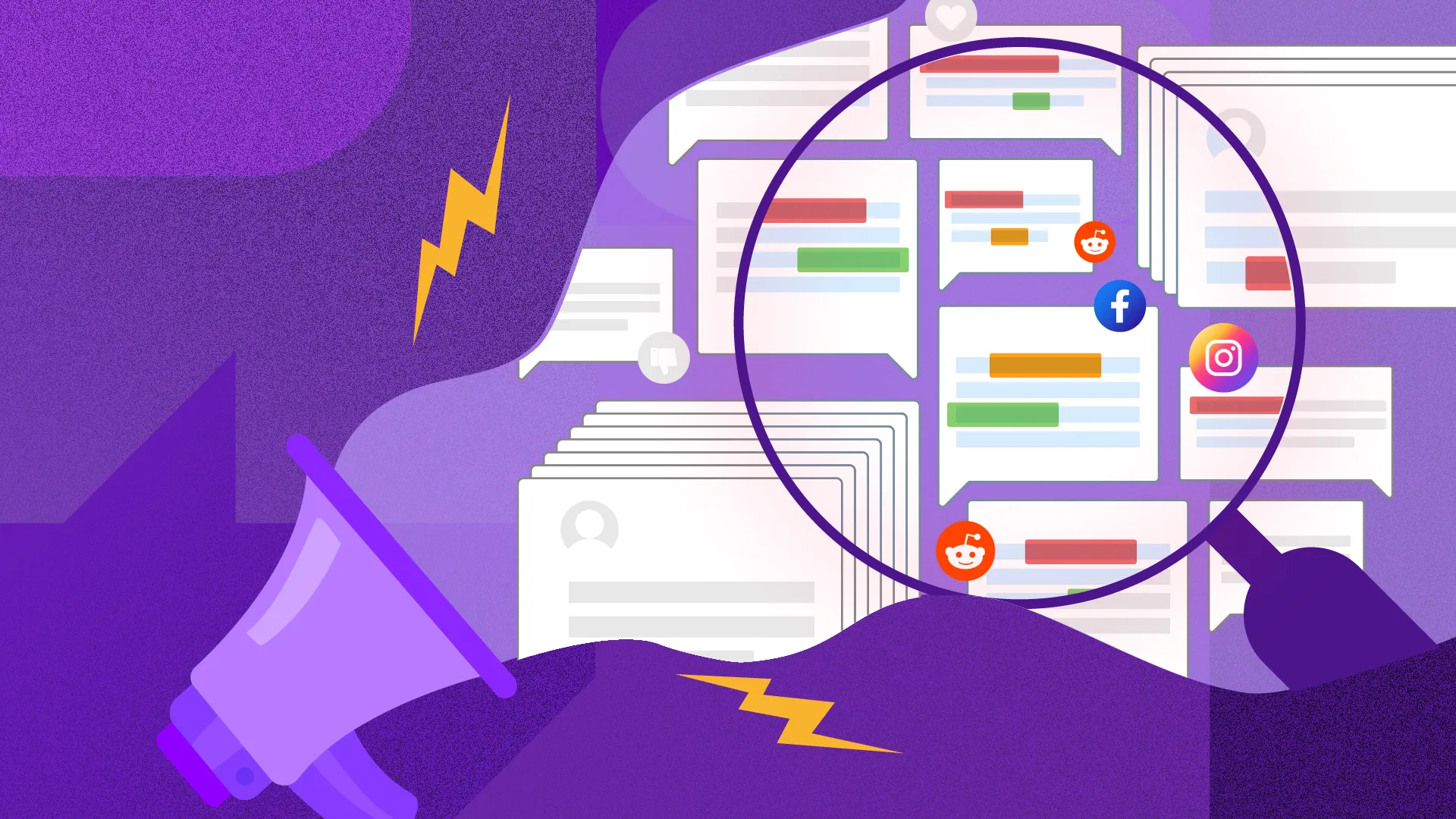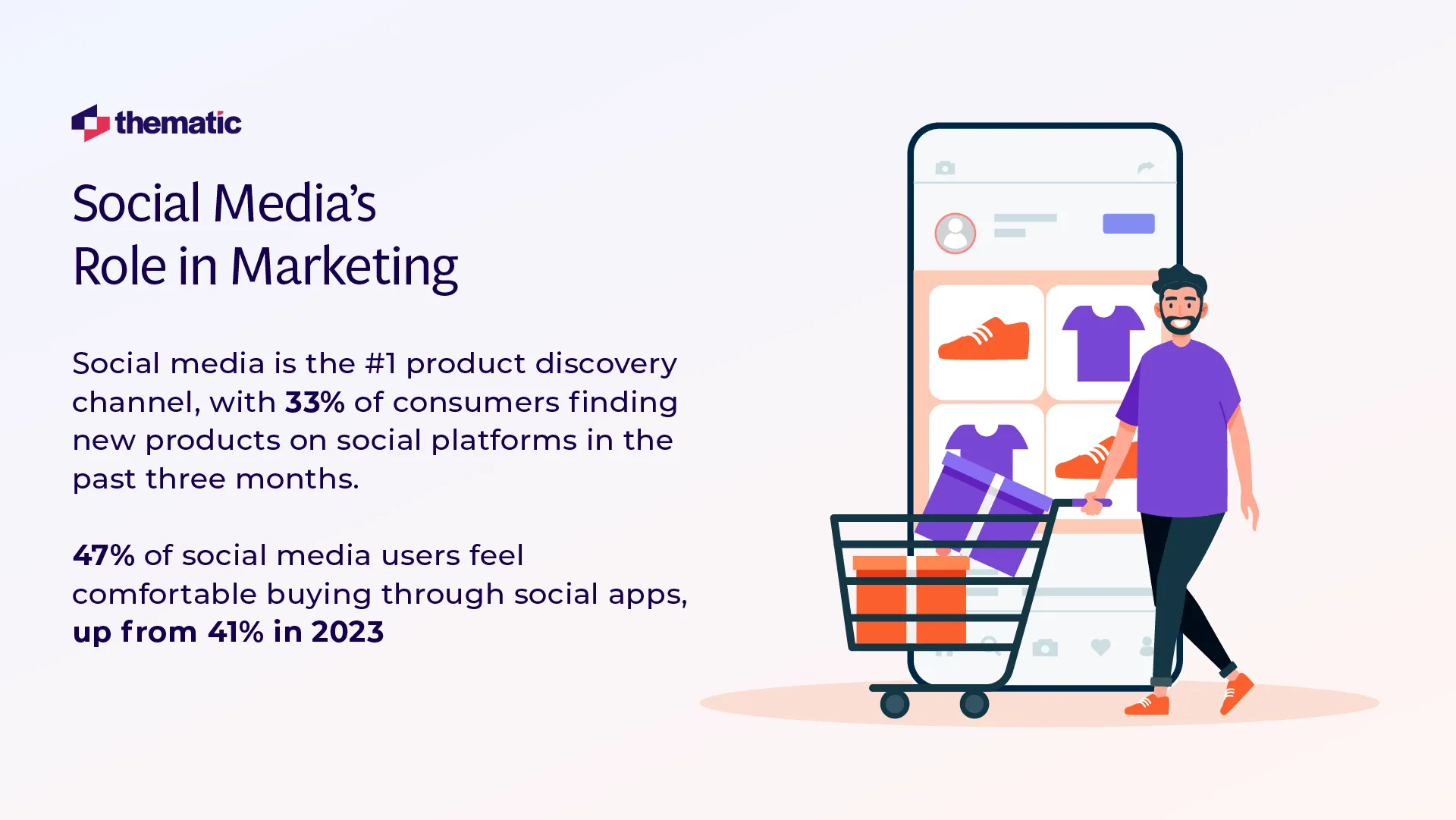
Discover how text analytics in marketing helps improve campaigns by providing customer insights and actionable strategies.

Have you ever launched a marketing campaign only to feel like it’s not hitting the mark with your audience? It’s frustrating, isn’t it? You might be wondering: What am I missing?
The answer could be hidden in your customer feedback.
Did you know that social media is the #1 product discovery channel, with 33% of consumers finding new products through platforms like Instagram and TikTok in the past three months?
With text analytics marketing, you can analyze feedback from sources such as social media and surveys to uncover valuable customer insights—helping you create campaigns that truly resonate.
Want to know how it works? Read on.
Have you ever wished you could get inside your customers’ heads and figure out exactly what they want? The good news is you don’t need a crystal ball—text analytics marketing can help. By analyzing feedback from reviews, surveys, and social media, this technology gives you a clear view of what your customers think and feel.
One key application of text analytics is sentiment analysis, which lets you understand whether customer opinions are positive, negative, or neutral. For example, if people love your product but complain about shipping delays, you know where to focus.
It’s not just about what they say but how often they say it. Recurring themes, like “great customer service” or “needs better packaging,” highlight what’s working and what isn’t. With this deeper understanding of customer behavior, you can tailor your campaigns to speak directly to their needs—and deliver what they’re looking for.
Just look at how MMGY used Thematic’s text analytics to help a global cruise line analyze customer feedback. They uncovered key themes like dissatisfaction with onboard purchases. These insights helped improve services and informed marketing strategies by highlighting pain points to address and features to promote, enabling campaigns to resonate better with target audiences.
Social media can feel like a never-ending stream of posts, comments, and reviews—but hidden in that stream are golden opportunities to connect with your audience. Did you know that 47% of social media users feel comfortable buying through social apps, and that number keeps growing? This makes social platforms one of the most influential spaces for discovering what your audience truly cares about—if you can sift through everything they’re saying.
With text analytics, you can transform the overwhelming volume of social media chatter into clear, actionable insights. Imagine being able to quickly identify patterns in posts, like customers raving about your new product design or expressing frustration over a recent change. Instead of spending hours on time-consuming manual reviews, text analytics tools let you see the big picture in minutes.
Take a hypothetical example: let’s say your brand launches a new eco-friendly product. Using Thematic text analytics, you notice that hashtags like #GreenLiving and #EcoShopping are trending in customer conversations. At the same time, customer review analysis reveals a pain point—customers are confused about recycling instructions. Knowing all these, you could craft a social media campaign that promotes product benefits while incorporating fun and a clear tutorial on recycling.
With real-time insights and by tracking trending conversations, you’re sure your marketing strategies are relevant and ahead of the curve.

Ever wondered how businesses manage to target you with ads that feel like they were made just for you? The magic lies in text analytics and NLP combined with machine learning.
Natural language processing, or NLP, and machine learning (ML) take the guesswork out of customer segmentation, helping businesses classify their audiences based on demographics, preferences, and behaviors.
Through qualitative data analysis, NLP can sift through mountains of unstructured feedback—like reviews, surveys, and even social media posts—to identify patterns and group customers into meaningful segments.
Meanwhile, ML takes it a step further by predicting customer needs and tailoring marketing efforts to those insights. For instance, a customer frequently mentioning “quick delivery” in reviews could be segmented as a “convenience-first” shopper, with ads promoting fast shipping targeted directly to them.
It’s no wonder 39% of marketers are now using generative AI for data analysis, according to a 2023 global survey. This technology isn’t just crunching numbers—it’s uncovering actionable insights that help brands deliver personalized experiences. Imagine using AI to detect an emerging trend among younger customers and launching a campaign that speaks their language before competitors even notice the shift.
The power of AI is no longer just in theory; it is now helping shape real-world success. In fact, Vodafone New Zealand used text analytics and NLP to analyze feedback from their Touchpoint NPS data. They found out key themes and segmented customers based on specific concerns. Having identified the most pressing issues for different customer groups, Vodafone prioritized improvements and tailored messaging. As such, they focused marketing efforts on what mattered most to their audience and soon after enjoyed a significant boost in customer satisfaction and engagement.

Text analytics also helps you adjust in real time based on what your audience is actually saying. If you’ve read our articles on What is Text Analytics and Benefits of Text Analytics, then you’ve come across the story of Starbucks, which used text analytics on Twitter (now X) during product launches to track customer sentiment in real time and adjust prices or coffee blends to make sure customers are happy.
By using tools like sentiment analysis, you can keep a finger on the pulse of customer reactions as they unfold.
Let’s shed more light on this: Imagine launching a new product campaign and noticing the voice of customer insights reveals confusion about pricing. Instead of waiting for the campaign to end and analyzing results later, you can act immediately—adjusting your messaging or creating an FAQ to address the confusion.
Negative feedback doesn’t have to spell disaster, either. With real-time monitoring, you can spot issues before they escalate. For instance, if a trending complaint emerges on social media, thematic analysis software can identify the underlying sentiment and help you craft a quick response to diffuse the situation.
The best part? You can optimize ad targeting and content dynamically. Say a live campaign is resonating well with eco-conscious customers. With this insight, you can shift your budget to promote similar eco-focused ads or refine your messaging to highlight sustainability even more.
Real-time adjustments keep your campaigns agile, relevant, and impactful—ensuring your marketing dollars are always well spent.
Surveys and reviews are also important sources of insights that could inform marketing campaigns. But they can be overwhelming when they flood in. Thematic analysis software, a tool powered by text analytics, comes into play here. It uses advanced text analysis techniques to uncover hidden patterns and trends in customer feedback that humans can easily miss.
So, just imagine your tool going through thousands of comments, grouping them into themes like "fast delivery" or "needs better support." By connecting these themes with metrics like NPS (Net Promoter Score) or CSAT (Customer Satisfaction Score), you can see exactly what’s driving your customer experience—both the good and the bad.
Let’s say reviews reveal customers love your product’s design but frequently mention issues with your app’s functionality. This insight isn’t just interesting—it’s actionable. You could use it to launch a campaign promoting the product’s strengths while simultaneously addressing app improvements.
By transforming raw feedback into clear, actionable trends, thematic analysis software helps you turn customer voices into marketing gold. You don’t just hear your customers; you act on their needs.
Text analytics alters the way marketers understand customers, shape strategies, and refine campaigns with actionable insights. From real-time sentiment analysis to uncovering trends in surveys, its ability to drive smarter decisions and enhance the customer experience is unmatched.
Tools like Thematic make it simple to turn feedback into meaningful results, fostering stronger connections with your audience.
Curious about how it works? Try Thematic on your own data and see the difference it can make. Don’t just gather feedback—use it to fuel impactful marketing strategies.
The next level of your campaigns starts here!
Join the newsletter to receive the latest updates in your inbox.